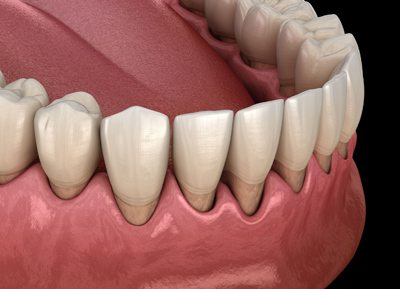

Your dentist has recommended a visit to a periodontist, a specialized dental professional who focuses on treating periodontal disease. This condition is a bacterial infection that affects the gum tissue, leading to symptoms such as inflammation, redness, swelling, and loss of bone around the teeth. It can impact a single tooth or multiple teeth. The National Institute of Health states that approximately 80 percent of adults in the United States have some form of periodontal disease.
The onset of periodontal disease begins with bacteria in the mouth attaching to the teeth. These bacteria accumulate and multiply, forming a biofilm known as dental plaque. When left on the teeth, this plaque can cause inflammation of the adjacent gingival tissues, resulting in the early stage of gum disease known as gingivitis. Practicing daily flossing and brushing with a bacteria-fighting toothpaste can help prevent gingivitis. Through regular oral hygiene practices, plaque and food debris are removed from the teeth's surface, and bacterial plaque at the gum line, helping to maintain gum health.
However, if plaque and debris are not effectively removed, and oral hygiene is not maintained, gingivitis can worsen. This can lead to increased inflammation, bleeding, and the formation of periodontal pockets, ultimately progressing into periodontal disease.
A periodontal pocket develops as the plaque bacteria from the biofilm accumulate and move below the gum line, making it challenging for home care to effectively remove the dental plaque. Without professional intervention, the biofilm continues to spread, infecting the inside of the pocket. The by-products produced by the bacteria in the plaque lead to degradation of the surrounding soft and hard tissues, resulting in deeper pockets. This advanced form of periodontal disease can affect the tooth roots, causing them to become infected, potentially leading to tooth mobility or discomfort, necessitating gum surgery. This initial therapy aims to treat diseased periodontal pockets through scaling and root planing. An ultrasonic scaling device is used by the dental hygienist to remove plaque, tartar, and debris below the gum line, followed by hand scaling to ensure smooth and disease-free tooth surfaces. This procedure may span two to four sessions, depending on the extent of oral disease.
1. Gingival Flap Surgery: Conducted for pockets deeper than 5 millimeters, this procedure aims to reduce the periodontal pockets. The periodontist separates the gum tissue from the teeth, performing a thorough deep cleaning to remove tartar, plaque, and biofilm below the pockets.
2. Gingivectomy: This procedure removes excess gum tissue, enhancing accessibility for effective teeth cleaning. The periodontist numbs the gum tissue and removes the surplus gum tissue.
3. Gingivoplasty: Used to reshape healthy gum tissue around the teeth for aesthetic purposes. If a person experiences tooth recession, a gum graft can be performed, where tissue is taken from the roof of the mouth and stitched into place on either side of the recessed tooth.
Following gum surgery, it's crucial to receive guidance from the periodontist or dental hygienist on proper teeth and gum tissue care using a toothbrush, antimicrobial fluoride toothpaste, floss, and antibacterial mouth rinse. For more detailed information on post-gum surgery care, consult your periodontal specialist or dentist.